CS self-study
Mon Dec 08 2025tags:
EDIT March 2021: As I become more confident and competent in my programming ability and ability to figure shit out on my own, I no longer need to follow a MOOC in order to learn. There's nothing wrong with MOOCs, of course, but the set of courses that have been packaged nicely into a MOOC is much smaller than the set of courses that have online materials. Not needing a MOOC to guide your learning opens up a lot of possibilities. It also helps a lot that I have found a group of friends in NUS SoC. Two of these courses I've recently taken are MIT's 6.824 Distributed Systems (taken with NUS folks as part of Do-Your-Own-Module), and Stanford's Computer Systems CS107e course. I plan to take CS 231n (CNNs) soon.
This page lists the massively open online courses (MOOCs) I've taken.
I will try to review the MOOCs, outlining why I liked/didn't like them,
what I learned, and whether I finished them.
This page details (some of) the courses I've taken. Here I put up notes I took during the courses, give my thoughts on some of the MOOC offerings, and talk about what I learned doing them.
MIT's 6.824: Distributed Systems
Why this course
Bernard and Liang Jun are doing this course as part of NUS's Do-Your-Own-Module (DYOM), and they kindly invited me to join. I've long wanted to learn more about distributed systems so I readily agreed. We meet every Monday to discuss seminal papers in the field: CAP, FLP, MapReduce, Aurora, Raft, and so on. I'm learning a lot about distributed systems from reading these papers, getting a bit of the "lay of the land", as it were. I'm also learning a lot about Golang and "thinking concurrently" by implementing the Raft consensus algorithm and building a kv-server atop it.
Course description
6.824 is a core 12-unit graduate subject with lectures, readings, programming labs, an optional project, a mid-term exam, and a final exam. It will present abstractions and implementation techniques for engineering distributed systems. Major topics include fault tolerance, replication, and consistency. Much of the class consists of studying and discussing case studies of distributed systems.
Notes I wrote on the course
Papers
- Self-studying MIT's 6.824 Distributed Systems
- Dean and Ghemawat (2004). MapReduce: Simplified Data Processing on Large Clusters
- Ongaro and Ousterhout (2014). In Search of an Understandable Consensus Algorithm [Raft]
- Rao, Shekita and Tata (2011). Using Paxos to Build a Scalable, Consistent, and Highly Available Datastore [Spinnaker]
- What is the CAP theorem really about?
- Notes on CRDTs
- Saltzer and Kaashoek (2009). Principles of Computer System Design: An Introduction
- FLP Impossibility Theorem
- Notes on Amazon Aurora (2017, 2018)
- Memcached at Facebook (2013)
- Notes on Dynamo (2007)
Labs
Stanford's CS107e: Computer Systems from the Ground Up
Why this course
Course description
Course description copied from the course page
CS107e: Computer Systems from the Ground Up is a variant of CS107 that teaches the fundamental concepts of computer systems through bare metal programming on the Raspberry Pi. Bare metal programming means you will not run an operating system on the Raspberry Pi and will make minimal use of libraries. This course also serves as an introduction to embedded systems. The course starts with the microprocessor and moves up to the C programming language, without skipping anything in between. The goal is to build a solid understanding of all aspects of how modern computers execute programs and how program development tools work.
The major learning goals for the course are:
- To understand how computers represent information, execute programs, and control peripherals.
- To master command-line programming tools and the C programming language.
Topics covered include:
- the ARM architecture
- assembly language and machine-level code
- the C programming language
- compilation, linking and loading
- debugging
- memory organization and management
- controlling peripherals: GPIO, graphics, sound, and keyboards
Students will receive a Raspberry Pi and a kit of parts, and all assignments will run on the Raspberry Pi. Assignments build upon each other by adding more and more functionality to a core library. They culminate in a simple personal computer shell using a keyboard and display. Finally, students do a project of their choosing where they build a complete hardware-software system.
Notes I wrote on the course
- Report on CS107E Assignment 1
- Report on CS107E Lab and Assignment 2
- Report on CS107E Lab and Assignment 3
Algorithms: Design and Analysis
Taught by Tim Roughgarden from Stanford University
An excellent course, but unfortunately I don't have access to my work anymore as Stanford retired their Lagunita platform.
From the Lagunita website:
Looking for your Lagunita course? Stanford Online retired the Lagunita online learning platform on March 31, 2020 and moved most of the courses that were offered on Lagunita to edx.org.
Learners who were actively engaged with the platform, as well as anyone who had been issued a Statement of Accomplishment, were notified throughout the beginning of 2020 that the Lagunita platform was closing. These learners were invited to download any course content and Statements of Accomplishments by March 31, 2020.
They've moved to edX.org now and you have to pay $149 USD for a verified certificate, but previously they were giving certificates for free.

From NAND To Tetris (N2T)
Taught by Noam Nisan and Shimon Shocken from Hebrew University of Jerusalem.
Best course ever: more on this in the future. Briefly, this is a project-based course that starts from the microscopic (NAND gates) and builds everything from there.
From NAND gates you first construct elementary logic gates. From those you build multiplexers and adders, which combine together to form ALU, CPU, RAM, ROM, and you have a computer.
So now you have a computer: the next step is to write software for it. You start off by writing machine code, but that's very unwieldy: Nisan and Shocken thus give you an assembly language spec and you write an assembler that converts assembly code to machine code. Obviously assembly code is not ideal either, so you again climb the ladder of abstraction and build a stack-based virtual machine (and yes, that means writing VM code, then writing code that parses VM code into assembler).
You climb again and build a parser and lexer to compile a high-level (something like C) language called Jack into that VM code. Now that you've built that high-level language you can then write OS functions (drawing images on the screen, arithmetic, etc.) and use those functions to write games on it --- games that include Tetris! (Hence the title).
The beautiful, genius, sublime part is that you've built every single rung of the ladder (from electrical circuits to high-level language) and you just get such a great understanding (and appreciation) for all those previous layers. It's a bit like those videos which start from a grain of sand and zoom out to an image of the Earth.
N2T I
First part of the course deals with the hardware: using the NAND gate to build multiplexers, half/full adders, then ALU/CPU/RAM/ROM. Then you write machine code and an assembler. It was quite easy for me, and I made it a bit harder by forcing myself to write the assembler/parser in C++.
Here's what the assembler looks like. Assembly code looks like this:
// Multiplies R0 and R1 and stores the result in R2.
// (R0, R1, R2 refer to RAM[0], RAM[1], and RAM[2], respectively.)
// Put your code here.
@i
M=0
@R2
M=0
(LOOP)
@R1
D=M
@i
D=D-M
@END
D; JEQ
@R0
D=M
@R2
M=D+M
@i
M=M+1
@LOOP
0; JMP
(END)
@END
0; JMP
You have to write code that converts that assembly code to the following machine code:
0000000000010000
1110101010001000
0000000000000010
1110101010001000
0000000000000001
1111110000010000
0000000000010000
1111010011010000
0000000000010010
1110001100000010
0000000000000000
1111110000010000
0000000000000010
1111000010001000
0000000000010000
1111110111001000
0000000000000100
1110101010000111
0000000000010010
1110101010000111
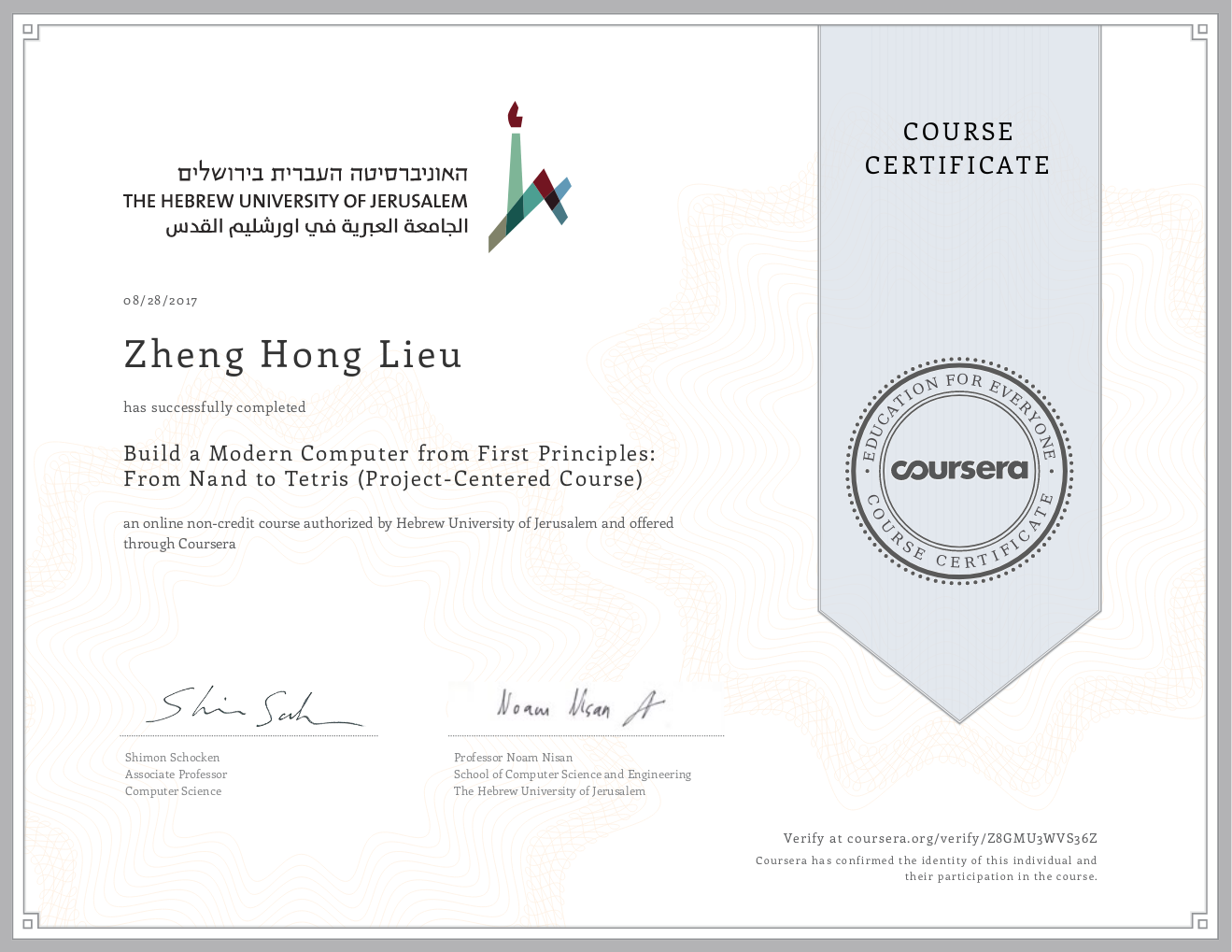
N2T II
The difficulty ramps up a lot in the second course and will really test your software engineering chops. First you will need to understand how a stack-based virtual machine works, and how it maps to assembly language.
A simple function in VM looks like this:
// This file is part of www.nand2tetris.org
// and the book "The Elements of Computing Systems"
// by Nisan and Schocken, MIT Press.
// File name: projects/08/ProgramFlow/BasicLoop/BasicLoop.vm
// Computes the sum 1 + 2 + ... + argument[0] and pushes the
// result onto the stack. Argument[0] is initialized by the test
// script before this code starts running.
push constant 0
pop local 0 // initializes sum = 0
label LOOP_START
push argument 0
push local 0
add
pop local 0 // sum = sum + counter
push argument 0
push constant 1
sub
pop argument 0 // counter--
push argument 0
if-goto LOOP_START // If counter > 0, goto LOOP_START
push local 0
And you have to write code to convert that VM code to assembly code:
// push constant 0
@0
D=A
@R0
A=M
M=D
@R0
M=M+1
// pop local 0
@R0
A=M-1
D=M
@R0
M=M-1
@R13
M=D
@0
D=A
@LCL
A=D+M
...
Then you will need to understand how high level code compiles down to the stack-based VM code. Which is even harder. You will need to write a parser/lexer according to a language grammar.
Once you've done that, you can use the high-level language to implement basic OS functions. With those we can then build a non-trivial program. I decided---in keeping with the namesake of the course---to build a game, and I wanted to build a game that had never been done before. I eventually settled on Bughouse Chess played on a 6x6 board.
That was pretty hard too. Jack is a "high level language" in the same way that C is a high level language, so lots of things were quite painful. Among other things, images are represented by arrays of 8-bit integers (0000 0000 = all white, 1111 1111 all black), and so to draw the sprites of my chess game I had to figure out the pixel calculations manually. You can see it in SpriteSheet.jack but it sort of looks like this:
let WPW[0] = 0;
let WPW[1] = 0;
let WPW[2] = 0;
let WPW[3] = -16384;
let WPW[4] = 12288;
let WPW[5] = 4096;
...
let WPW[61] = 1023;
let WPW[62] = 0;
let WPW[63] = 0;Really really rewarding though.
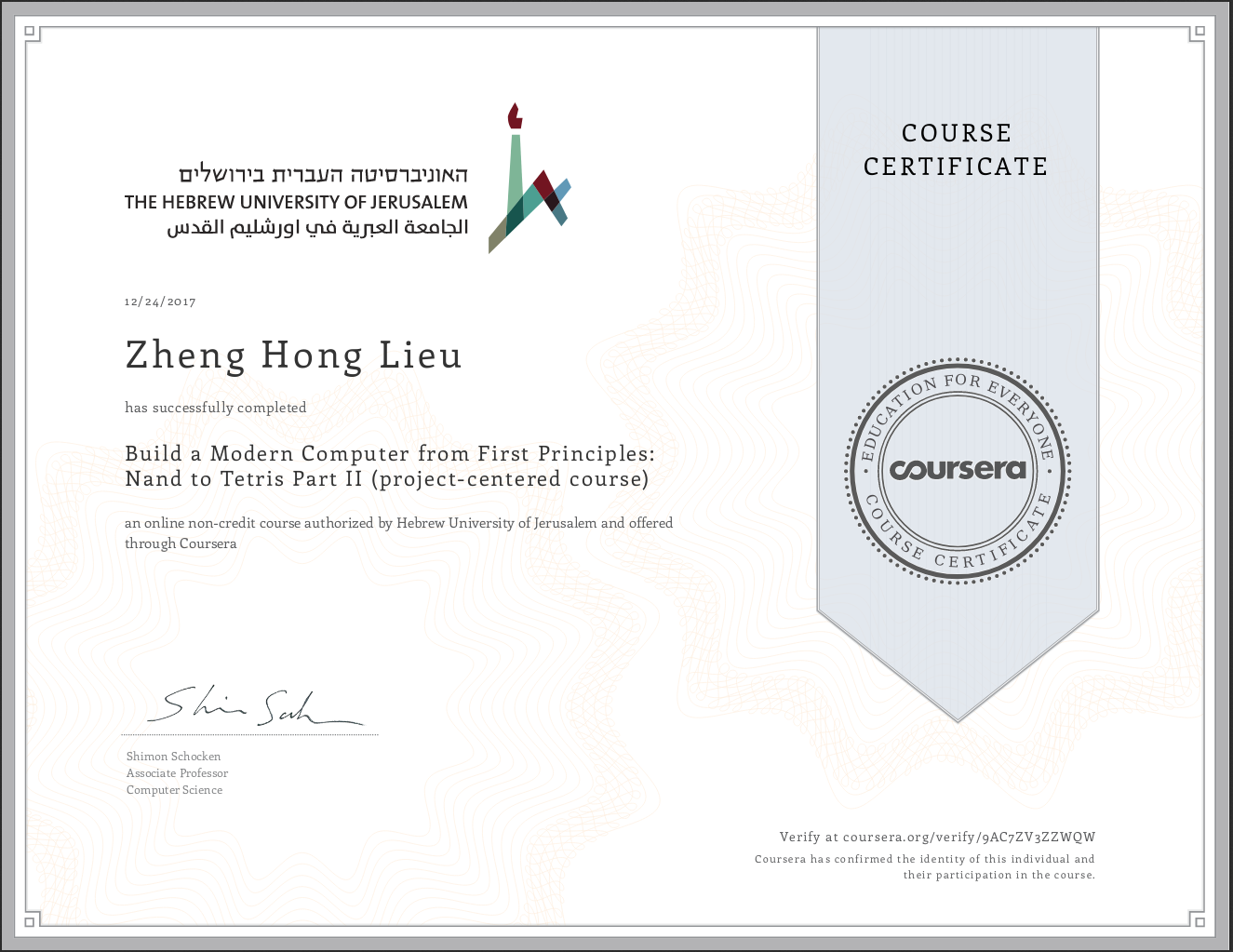
Functional Programming in Scala Specialisation
The link to the Specialisation is here. The description:
This Specialization provides a hands-on introduction to functional programming using the widespread programming language, Scala. It begins from the basic building blocks of the functional paradigm, first showing how to use these blocks to solve small problems, before building up to combining these concepts to architect larger functional programs. You'll see how the functional paradigm facilitates parallel and distributed programming, and through a series of hands on examples and programming assignments, you'll learn how to analyze data sets small to large; from parallel programming on multicore architectures, to distributed programming on a cluster using Apache Spark. A final capstone project will allow you to apply the skills you learned by building a large data-intensive application using real-world data.
Learners will build small to medium size Scala applications by applying knowledge and skills including: functional programming, parallel programming, manipulation of large data sets, higher-order functions, property-based testing, functional reactive programming.
I found the first and fourth courses excellent (and I completed them), the third course good (completed all but the last assignment), and the second one incredibly bad. The second course seemed to be missing more than half of the lecture videos and was impossible to follow.
Functional Programming Principles in Scala
Taught by Martin Odersky from EPFL
Verification link for Functional Programming Principles in Scala
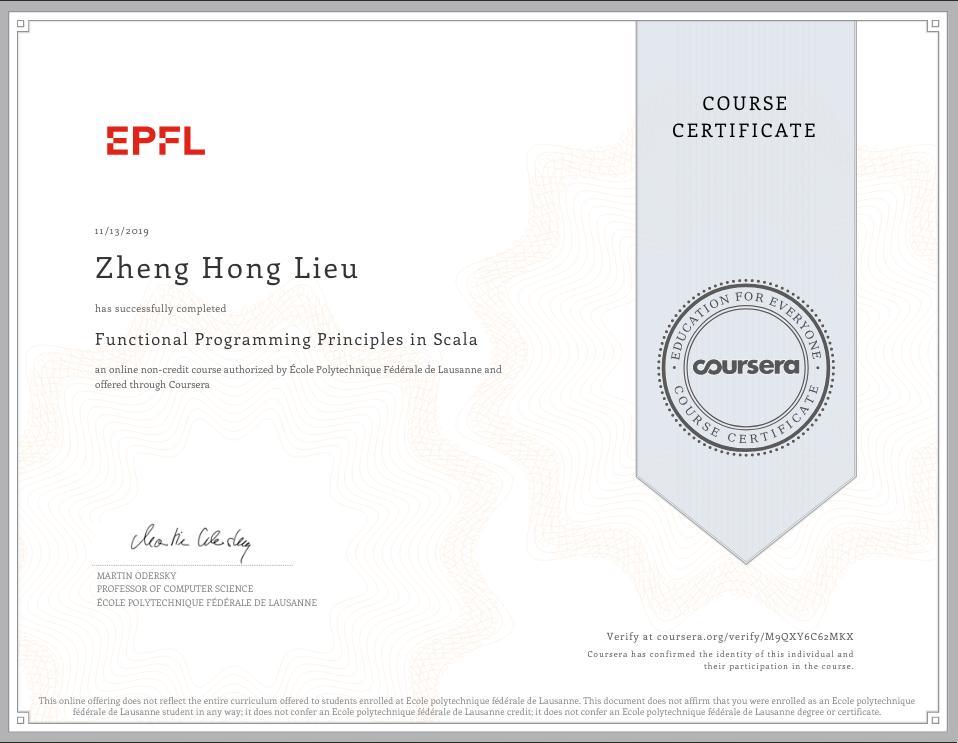
Big Data Analysis for Scala and Spark
[Verification link for Big Data Analysis with Scala and Spark] (https://www.coursera.org/account/accomplishments/records/CSFJQZEQFBHD)
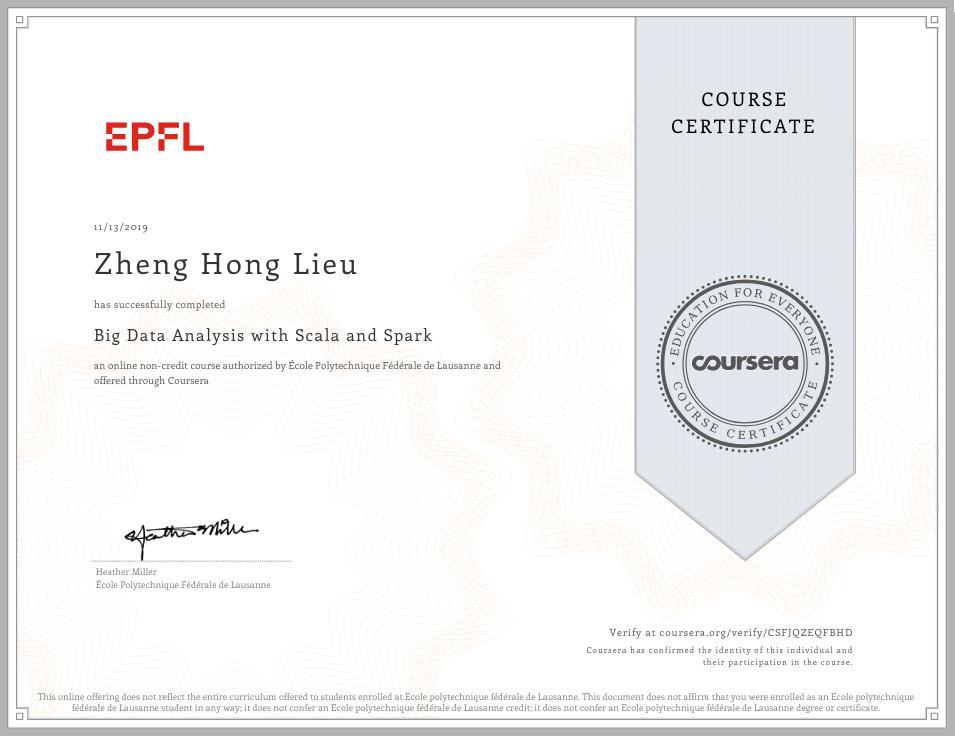
Machine Learning
Taught by Andrew Ng from Stanford University

Mathematics for Machine Learning Specialisation
This was largely a box-ticking exercise because I needed to demonstrate that I had done linear algebra and multivariate calculus for the purposes of my Master's admission.
I didn't like these courses because they were too easy and not rigorous enough.
Linear Algebra
Verification link for Mathematics for Machine Learning: Linear Algebra
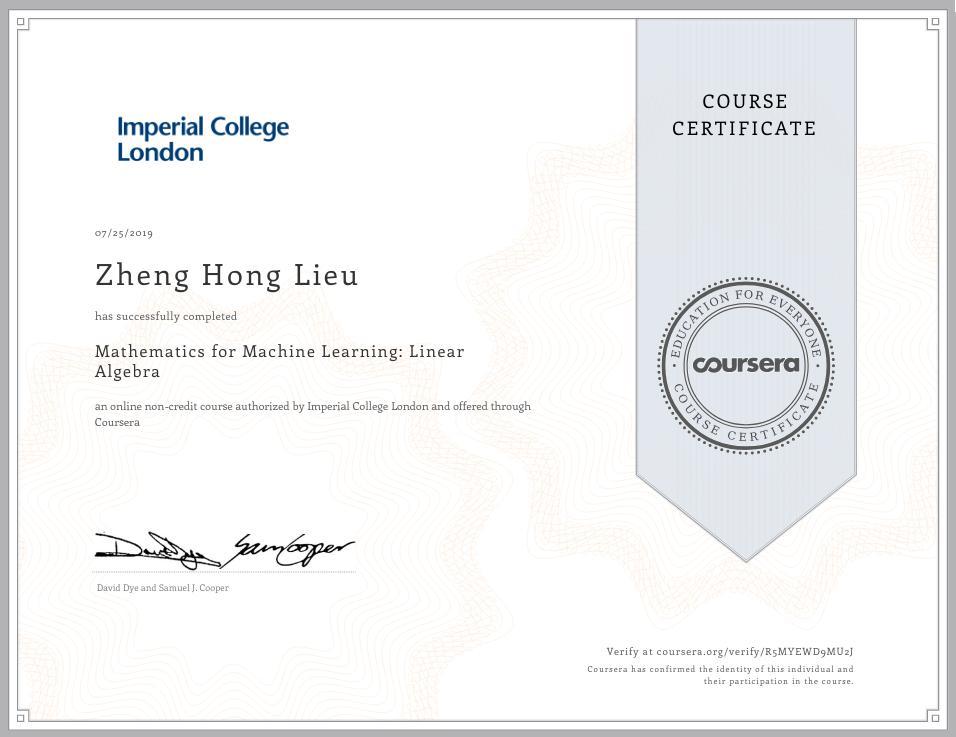
Multivariate Calculus
Verification link for Mathematics for Machine Learning: Multivariate Calculus

Databases
This entire series---taught by Jennifer Widom and hosted on the now-defunct Stanford Lagunita platform--- is excellent. Rigorous and compsci look at the theory of databases (relational algebra, 3NF/4NF/BNF), with many brain-bending query/SQL exercises.
I took this during the 2019 summer internship with Inzura to learn just enough to start building my own PostgreSQL database for the Bayesian SMS sender pipeloop. I completed DB1, DB4 (Relational Algebra), and DB5 (SQL)
DB1 Introduction to Databases
An excellent introduction for those with no prior knowledge (ergo me). Easy course by design.
DB4 Relational Algebra

DB5 SQL
The certificate is unfortunately lost to time.
Competitive Programmer's Core Skills
Competitive programming course taught by Russians. I took it mainly as a forcing function to get more CP practice in when preparing for job interviews back in 2019.
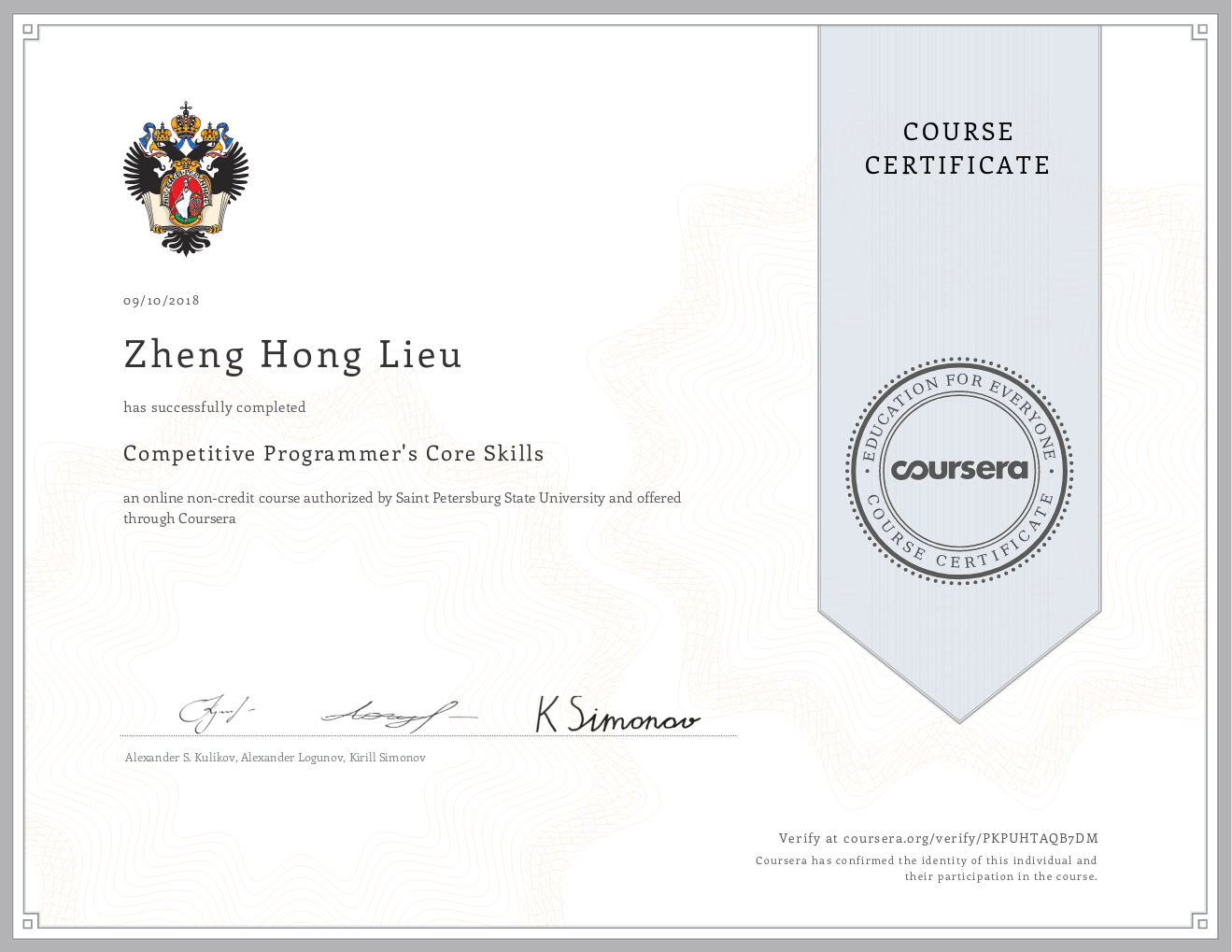
DevOps Essentials
A Udemy course I did for work. Not much to it: two hours of videos. But good for getting a overview of what DevOps is and key terms (what is the difference between continuous integration/deployment/delivery? what are microservices?
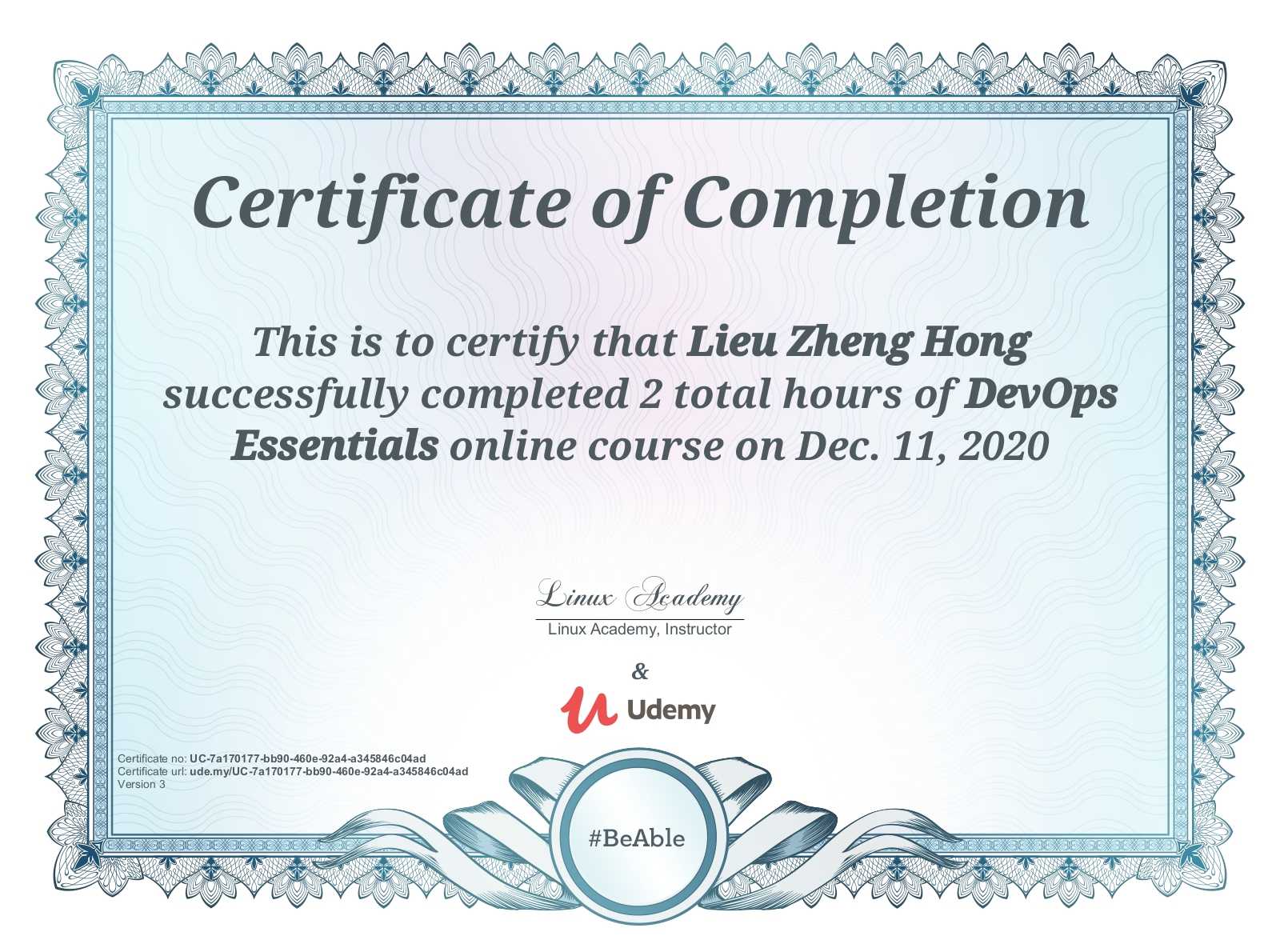
AWS Serverless APIs & Apps -- A Complete Introduction
